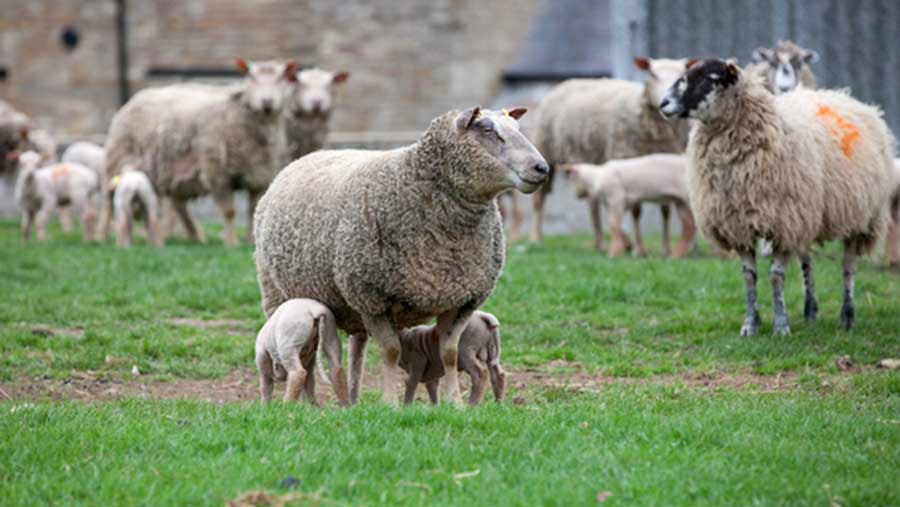5 tips to tackle coccidiosis in the lambing season
 © Tim Scrivener
© Tim Scrivener Coccidiosis is one of the most prevalent and costly diseases among lambs, making prevention, diagnosis and a proactive approach extremely important.
Kate Phillips, an independent sheep consultant, gives her five top tips to help avoid coccidiosis damaging your flock this season.
See also: Q&A: How to treat and prevent coccidiosis in lambs
What is coccidiosis?
Coccidiosis is a disease caused by coccidia oocysts – microscopic parasites – that hatch in the gut and cause damage to the gut lining. Almost all lambs will be host to coccidia and most of these are not harmful.
Of the many coccidiosis species found in sheep – only two cause disease and are known as “pathogenic”. These pathogenic species are Eimeria ovinoidalis and Eimeria crandallis.
Both species cause clinical disease, where the typical clinical signs (weight loss, scouring, deaths) are seen, but also the more insidious subclinical disease, where the only real sign is reduced growth rate.
What are the symptoms?
Those most susceptible are lambs aged four to 12 weeks and the first sign is often diarrhoea.
However, it is not uncommon in lambs over three months old where sub-clinical signs will show weight loss and even death.
When you work with your vet, good records are even more important, as they can identify a problem and suggest a solution much quicker if there’s performance data to go on.
Treatment
The key to dealing with the disease is prevention and control.
Prevention strategy includes lowering or eliminating the numbers of pathogenic oocysts ingested by implementing good biosecurity, hygiene and management.
Control strategy involves using timed and preventative treament with one of the licensed medicines available.
1. Feed ewes well to ensure quality colostrum
The chance of any disease taking hold is likely to be significantly reduced if you make sure every lamb has a full dose of quality, antibody rich colostrum.
National Animal Disease Information Service (Nadis) recommends 200ml/kg lamb liveweight during the first 24 hours of life, with 50ml/kg within the first two hours.
This gives the lambs the best chance to defend themselves, using maternal immunity from the ewe, while allowing them to build their own immunity in the early stages of life.
With coccidiosis, lambs need to be exposed to the parasite, to ensure they build their own natural immunity.
This is one of the reasons it is not advisable to treat ewes with in-feed coccidiostats as part of a coccidiosis management plan; the very low level oocyst shedding by the ewe plays a large part in allowing the lamb to build its own immunity.
2. Measure lamb performance – weigh your lambs
Weighing lambs gives a huge opportunity to identify issues which may otherwise go unnoticed. This is particularly valuable in older lambs later in the season.
This means you can identify any growth issues earlier, when lambs aren’t ‘doing’, and react more quickly if a coccidiosis issue is suspected.
3. Stay on top of hygiene
Good hygiene is critical to reduce disease risks but these checks are often underestimated because they seem so simple.
Once lambs are turned out, keep areas under the creep feeders or water troughs free of heavy soiling with lamb faeces and deal with any poaching. These are the areas that build up a really high coccidiosis challenge.
One single oocyst taken in by a lamb can multiply into 16 million, which are then deposited back on to the ground, increasing the infection pressure in the environment for other lambs. Once a few lambs are infected, the disease can very quickly take hold of the rest.
Mrs Phillips encourages farmers to work with their vet to create a robust flock health plan, taking particular care to implement effective hygiene routines and protocols.
“Be hygienic and sensible about where animals are eating, and how many are in one area at one time. Move creep feeders regularly, keep feed and water troughs cleaned out properly and provide fresh, dry food.”
4. Get the correct test for pathogenic coccidiosis
Timing is key when it comes to testing for and treatment of coccidiosis, which makes understanding the disease picture on your farm very important.
Work closely with your vet and use a test which can identify whether pathogenic coccidia species are present on your farm, so you can ensure planning and the appropriate treatment is given at the right time.
According to Mrs Phillips, most people treat stock when they see clinical signs, but the benefits are much greater if you are proactive about controlling coccidiosis, before losses occur.
If you wait until clinical signs are present, lambs will already have significant gut damage which impacts performance and can result in lamb losses.
It’s more effective to treat lambs for coccidiosis after they have had exposure, but before clinical signs develop. That way, you avoid the costly weight check which the lambs will never catch up.
In older lambs, a lot of farmers get faecal worm egg counts done, and at the same time, coccidial oocyst counts. But for this to be any use, you would need to know if the species present are ones that are harmful and cause disease.
5. Get a postmortem examination
Finding out why animals die is very valuable information for building a full picture of your on-farm disease challenges.
With most farmers needing to reduce costs of production, reducing losses is a key way to improve output. Sheep farmers need to be work with their vets to create proactive health plans to achieve this.
